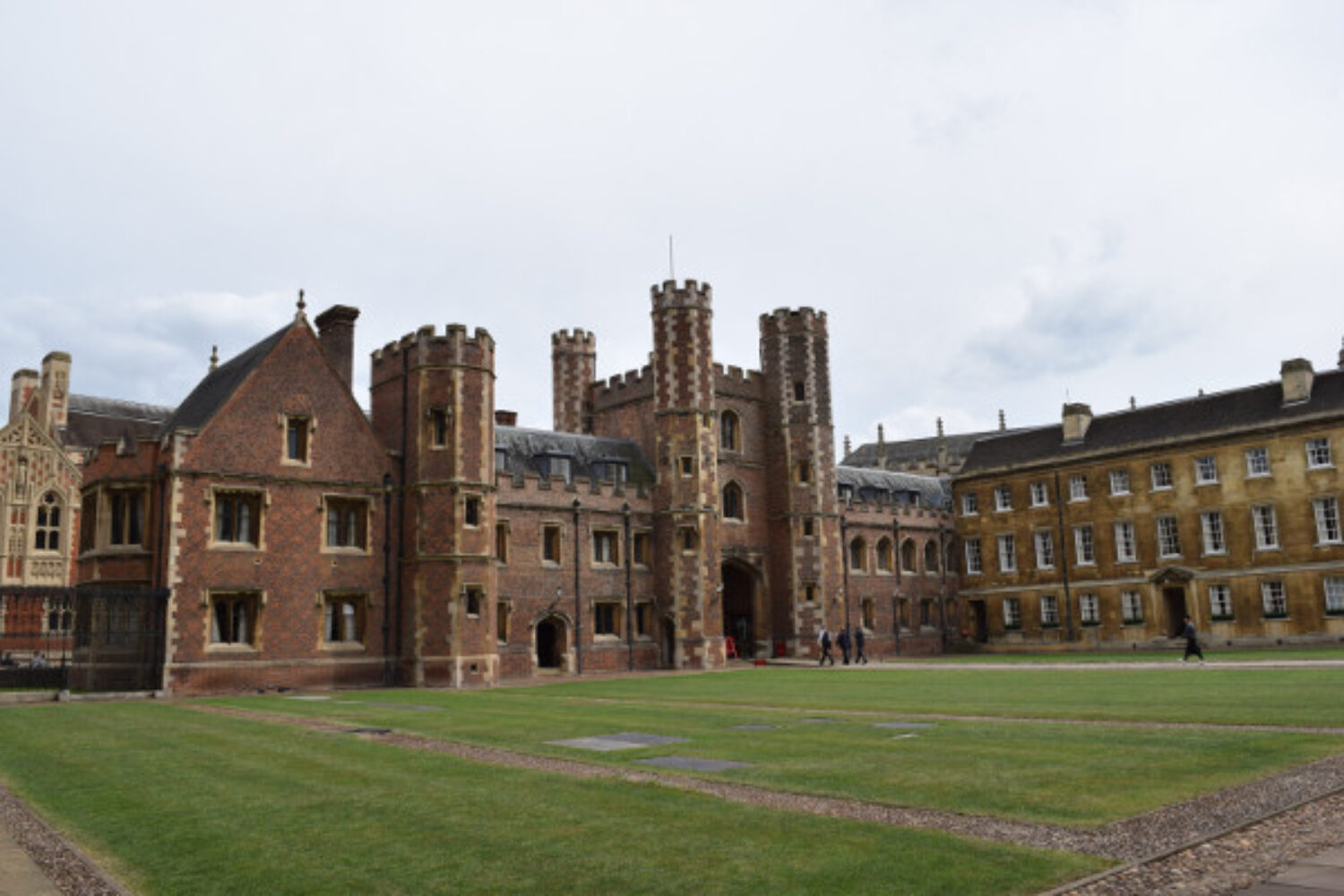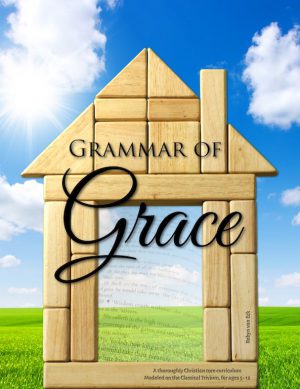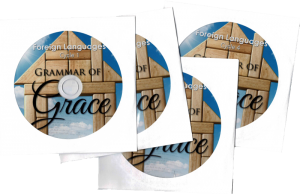Photo by Fabien Jolicoeur on Unsplash
One of the first questions people usually ask us is: How does this work? This excerpt from the Instructions gives you an overview of what daily homeschool looks like with Grammar of Grace. It’s long, so if you’re looking for details, this is the article for you.
(Excerpted from Grammar of Grace.)
If Classical education is new to you, you’re probably wondering how a curriculum like this works. It’s amazingly simple! The Grammar of Grace core subjects should only take about an hour every day―30 minutes for memory lessons, 15 for Bible reading, and 15 for copywork. Add in 30 minutes for phonics and about an hour and a half for reading aloud, and you’re completely done in 3 hours every day―and most of it was sitting on the couch reading together. Yet you will be amazed at how much your children learn in that short amount of time! Before I get into the specifics, though, let’s review what the Trivium is, and where Grammar of Grace fits into it.
Early in the Christian Era, Boethius and others codified the Classical education into seven subjects, divided into the Trivium, which was the basic education, and the Quadrivium, which was the higher education. These seven subjects were known as the Liberal Arts; they are:
Trivium
• Grammar
• Logic
• Rhetoric
Quadrivium (university-level)
• Arithmetic
• Geometry
• Harmonics, or Music
• Astronomy
The Trivium
Trivium is Latin for “three ways”. The Trivium was used to educate young people in the Christian West from about AD 500 to 1900. Before that, the Greeks and Romans followed the same basic method, even if they hadn’t named it and set it down as a formal curriculum, and many authors will credit these ancient pagans as the source of Classical Education. However, centuries before that, there were Three Things Solomon told young people they should get at all cost in the book of Proverbs, which bear a striking resemblance to the Three Ways:
• Knowledge: The possession of information, like Grammar.
• Understanding: The ability to think about things rationally, like Logic.
• Wisdom: The ability to use the knowledge and understanding one possesses to discern wisely, and then to communicate that discernment effectively. The communication element of Wisdom is taught in Rhetoric.
This parallel is brought out and explained in greater detail in Harvey and Laurie Bluedorn’s excellent book, Teaching The Trivium.
Grammar of Grace
Grammar of Grace is designed for the Knowledge, or Grammar, stage. Beginning around age 5, children should be taught to memorize all sorts of wonderful things, called lessons, and to recite them, recitation; they should also be read to, and taught to read (phonics) and write (copywork).
The heart of this curriculum is over five hundred lessons, in seven subjects, designed to form good character, stimulate a love for beauty and excellence, and (of course) provide basic knowledge, creating a foundation in the child’s mind. The fear of the Lord must be the foundation of it all (see Proverbs 9:10). “For from Him and through Him and to Him are all things!”
CORE SUBJECTS
So how do those 30 minutes of memory work go? Seven subjects, to fill their minds with things that are good, lovely, and profitable…
I. Bible Lessons
You ask the prompt question, and teach the children to give the answer, including the scripture reference.
II. Bible Passage
On New Lessons Day, teach the new verse of the Bible Passage just like you teach the other lessons. The prompt is the title; for example, in Cycle 1 Week 1, I say, “The 10 Commandments,” and they answer, “Then God spake all these words, saying … .” After they learn the new verse, they add it to the rest. So, for example, in Cycle 1 Week 3, once I’ve taught them the new verse, I would say, “The 10 Commandments,” and they say (with my help), “Then God spake all … ,” all the way through, “ … that love me, and keep my commandments.”
I like to make up handmotions for my children to help them learn the Bible Passages, and they love it.
III. Scripture Catechism
This subject is The Child’s Scripture Catechism, by H. M. Eaton and Harvey Bluedorn; used by permission. These scriptures are in King James Version, except where there was overlap with material in the Bible Lessons subject, where I switched them to Geneva for simplicity’s sake. The children do not need to memorize scripture references for the catechism.
IV. Foreign Languages
A Classical education includes learning foreign languages, namely the Classical languages. The study of foreign tongues sharpens a child’s mind in a way no other subject can, readying him for his later subjects. The Reformers prioritized teaching Classical languages, desiring for their children to have access, first and foremost, to the Holy Scriptures in their original languages, but also to a wealth of other writings. It is natural―it is easy―for children to learn foreign languages, and the earlier they can begin learning them, the better.
The Grammar of Grace Foreign Languages subject is designed to let your child hear and speak Latin, Greek, Hebrew, and Dutch, just like he has heard and spoken English from an early age. The goal is for him to be familiar with these languages, naturally, from childhood. Each of these lessons is learned in the foreign language and English. We do not say the references.
Because foreign languages are a bit of a different animal from all of the rest of our subjects, please see “Teacher’s Guide for Foreign Languages” and “Teacher’s Guide for Hebrew”, on pages 181-214, for detailed instructions about how to teach this subject. (Note: There are audio CDs to help with this subject.)
The Latin translation used is the Vulgate; the Greek, the Textus Receptus (1550 Stephanus); the Hebrew, the Masoretic (Westminster Leningrad Codex); and the Dutch, the Statenvertaling. I chose Greek scriptures that are in A Greek Alphabetarion, by Harvey Bluedorn, which the children will study in-depth when they start the Christian Grammar School at Home: Later Knowledge Guides.
V. History
Rather than teach “values-neutral” statements crafted by modern historians, I selected quotations from people and documents which were noteworthy in history; in other words, the children are memorizing actual pieces of history. The dates of these events or people’s lifetimes are noted in the History Memory Master pages.
I have left out far more than I’ve included. But this will place a lot of names and ideas in the children’s minds, to spark a lifelong understanding of and love for history. Initially, I included quotes from villains in history like Karl Marx and Plato, to teach about how dangerous ideas can cause great harm. But the words that children memorize early are almost, as I said, carved in stone upon their minds, and careful consideration led me to include only words that encourage the formation of good character. There will be plenty of time for studying Rousseau and Darwin when the children have developed a mature understanding of Right and Wrong.
Occasionally, a history quote will be longer than a sentence or two, such as the Apostles’ Creed or the Mayflower Compact; those selections are carried over for two or three weeks. When you get to one of these, simply read it a couple of times each day, and on the day when you would normally drill new material, read it two or three times. The children will pick it up.
A few of the History lessons are also written in their original languages of Latin, Greek, or Dutch. This extra information was included for your interest, and need not be learned!
VI. Timeline
There are five timelines in Grammar of Grace. The Timeline of World History is a traditional world history chronology; there are three king lists which can be taught using songs; and we also memorize the books of the Bible. For each complete timeline, add on, week after week, just like you do with the Bible Passage. The information in grey, such as dates, is only for informational purposes, and should not be recited.
The Timeline of World History names events and people, from the Beginning to present; it is learned over the course of the first 2 cycles. Dates are taken from Archbishop James Ussher’s Annals of the Ancient World, Sir Isaac Newton’s Revised History of Ancient Kingdoms; Dr. Floyd Nolen Jones’ The Chronology of the Old Testament; and S.C. Adams’ Synchronological Chart or Map of History, as well as the more usual modern sources, such as Enclyclopedia Britannica. Dates before Christ are given in AM dates, or Year of the World. We memorized the Timeline of World History using handmotions. Even my six-year-old can say the whole thing. (Although, my eight-year-old can’t do it without prompts, here and there, even though she really does know it; they’re all different.)
During Cycles 3 and 4, the king lists and books of the Bible are memorized. I use songs for almost all of this material; it’s very easy for the children that way. Here are my suggestions for learning the king lists:
Cycle 3:
- There’s a little song for Christ’s lineage, from Adam through Terah, on page 217.
- Look online for a cute song by Andrew Peterson called “Matthew’s Begats”, which covers the rest.
- The books of the Bible can be memorized in little groups of 3-6, and the weekly assignments are divided that way; there are also songs out there, if you prefer.
Cycle 4:
- There’s a song for the first 18 presidents of the United States on page 218.
- There are lots of songs you can find, out there, for the presidents from Washington, on.
- There’s a song for the kings of England prior to the Norman Conquest on page 219.
- You can find songs or poems on the internet for memorizing the monarchs from William the Conqueror, on.
VII. English
At the end of the children’s other six lessons, every day, simply read or sing the English selection, once.
After a week or so of presenting a poem or hymn, you may ask the children to try and say (or sing) it with you. Over time, they just pick it up. The idea is that this is a treat, to cap off the morning’s hard work; relax and enjoy the beauty of the melody, the depth of the text, and the rhythm and rhyme of the poetry.
By the time you move onto the next selection, the children should know the one you’ve been reading or singing fairly well. Because the English subject alternates between poetry and hymns, if you continue reading the most recent selection while you’re learning the current one, you’ll read one poem and sing one song every day, and that extra time with each piece will ensure the children completely memorize all but the longest ones.
For example, in Cycle 1, Week 7, when I begin singing “And Can It Be” for the children in our daily memory lessons time, after I sing that each day, time permitting, I also read “The Village Blacksmith”. Then, in Week 12, I drop “The Village Blacksmith” for “Faithful Sings …”, but continue singing “And Can It Be”. In Week 13, I drop “And Can It Be” and sing “Holy, Holy, Holy,” but keep reading “Faithful Sings …”. So, again, time permitting, I sing one hymn and read one poem every day, to give the children a few extra weeks hearing each one of them. This isn’t necessary―the regular assignment is enough to make the children deeply familiar with each of the selections, enriching their minds with the depth and beauty of our language―but that’s what I like to do.
Over each Christmas Break and Summer Vacation, there is an additional hymn to sing with the children, which is printed in the Memory Master section.
Bible Reading
During the Knowledge (Grammar) years, mother will read the entire Bible aloud to her children twice. The Bible Reading Plan has assignments for four days a week, for the 24 weeks of each cycle. Each reading is about fifteen minutes long. I placed the Bible Reading Plan at the end of this book, to make it easy to turn to, every day. See page 243 for more detailed instructions.
Copywork (Writing)
Progressive educational programs teach creative writing at this stage. Nonsense. The primary means for teaching writing at this age, historically, has been having the children copy well-formed examples of writing that also teach eternal truths. Children should copy great literature, especially the Bible. Teach cursive writing from the start, and require good penmanship. There is a worthy selection of scriptures in the Copybook, arranged progressively. Anything else in this book would do nicely, as well (including the Foreign Language lessons); the New England Primer and Webster’s Old Blue Back Speller are also excellent. There are detailed instructions at the beginning of the Copybook, on page 223.
Less formally, journaling and letters to Grandma and Grandpa are excellent means for allowing the children to learn how to formulate their own thoughts.
Those are the core subjects of Grammar of Grace; they’re quite different from the typical curriculum! With children under the age of 10, you’ll want to add in a phonics curriculum and make sure you read aloud to your children; that is all!
Don’t get too excited… The academics become more rigorous, around age 10, and that’s what the Christian Grammar School at Home: Later Knowledge Guides are for. But for younger children, there really shouldn’t be hours of schoolwork, bent over a desk, every day. This really is enough!
If you’re looking for even more details, you download a sample of Grammar of Grace here; it contains the full instructions and plenty more.
Thanks for dropping by; please keep us in prayer!



